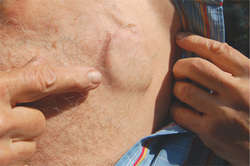The unfortunate truth about asthma is that we don't know what causes it. Asthma itself is a chronic inflammatory disease of the airways which can affect people in different ways. The one way that everyone experiences it the same, however is that the airways to your lungs meet a trigger and swell up, narrow, and fill with mucus. This can mean spasms, difficulty breathing and other kinds of wheezing and resistance.
What we do know is that there are certain triggers that seem to be fairly consistent for asthma. One is allergens. The majority of people who have asthma also have some allergy to an airborne substance. However, around 20% of people do not, so the two aren't necessarily linked. For others, food will cause an asthmatic reaction, which also sounds a lot like an allergy problem. Smoking and some medications can also cause similar reactions and triggers for asthma.
However, there are non-substance based triggers. For example, exercise can induce an asthma attack, or even simply having heartburn. On top of this, you can find weather and emotions also causing the asthma to hit.
For most sufferers of asthma, it's essential that they keep a record of what has happened when an asthma attack occurs. Because of the enigmatic nature of asthma, it's up to each patient to figure out what his/her triggers are and maintain them on a personal level.
What we do know is that there are certain triggers that seem to be fairly consistent for asthma. One is allergens. The majority of people who have asthma also have some allergy to an airborne substance. However, around 20% of people do not, so the two aren't necessarily linked. For others, food will cause an asthmatic reaction, which also sounds a lot like an allergy problem. Smoking and some medications can also cause similar reactions and triggers for asthma.
However, there are non-substance based triggers. For example, exercise can induce an asthma attack, or even simply having heartburn. On top of this, you can find weather and emotions also causing the asthma to hit.
For most sufferers of asthma, it's essential that they keep a record of what has happened when an asthma attack occurs. Because of the enigmatic nature of asthma, it's up to each patient to figure out what his/her triggers are and maintain them on a personal level.

 RSS Feed
RSS Feed